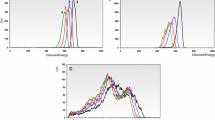Abstract
Rapid detection and quantification of gross alpha/beta-emitting radionuclides by liquid scintillation counting (LSC) is vital in guiding response to a nuclear or radiological incidents. Liquid scintillation counters use signal pulse shape to discriminate alpha and beta events in samples but require precise optimization to minimize the spillover, or misclassification, of those events. In this study, samples at varying activity levels were analyzed by LSC to determine the effect of activity level, emitter type, and sample matrix on spillover. Analysis proved a matrix effect and a direct correlation of activity level on spillover percentage for both alpha and beta emitting-nuclides.





Similar content being viewed by others
References
Salonen L, Hukkanen H (1997) Advantages of low-background liquid scintillation alpha-spectrometry and pulse shape analysis in measuring 222Rn, uranium and 226Ra in groundwater samples. J Radioanal Nucl Chem 226:67–74. https://doi.org/10.1007/BF02063626
Schonhofer F (1998) The use of low-level liquid scintillation spectrometry for rapid measurement and decision making. Radioact Radiochem 9(3):18–24
Kaihola L (2000) Radionuclide identification in liquid scintillation alpha-spectroscopy. J Radioanal Nucl Chem 243:313–317. https://doi.org/10.1023/A:1016032921544
L’Annunziata M (ed) (2004) Handbook of radioactivity analysis, 2nd edn. Academic Press, New York. https://doi.org/10.1002/anie.200385104
Piraner O, Jones R (2021) Urine gross alpha/beta bioassay method development using liquid scintillation counting techniques. J Radioanal Nucl Chem 327(1):513–523. https://doi.org/10.1007/s10967-020-07493-y
Piraner O, Jones R (2009) Urine gross alpha/beta analysis by liquid scintillation counting for emergency and terrorism preparedness and response. In: Eikenberg J, Jäggi M, Beer H, Baehrle H (eds) LSC 2008, advances in Liquid Scintillation Spectrometry, Radiocarbon, First Edition. Department of Geoscience, University of Arizona
Sas D, Janda J (2017) Rapid determination of gross alpha/beta activity in urine with LSC. J Radioanal Nucl Chem 311:23–27. https://doi.org/10.1007/s10967-016-5077-x
Çakal G, Güven R, Yücel H (2015) An application of LSC method for the measurement of gross alpha and beta activities in spiked water and drinking water samples. Nukleonika 60(3):637–642. https://doi.org/10.1515/nuka-2015-0089
Li X, Wang S, Lou H, Pan J, Dong Q, Zheng Y, Chen L (2022) Simultaneous determination of gross alpha/beta activities in water by liquid scintillation counting and its application in the environmental monitoring. Sci Rep 12(1):8281. https://doi.org/10.1038/s41598-022-12245-x
Abdellah WM (2013) Optimization method to determine gross alpha-beta in water samples using liquid scintillation counter. J Water Res Prot 5:900–905. https://doi.org/10.4236/jwarp.2013.59092
Stojkovic L, Tenjovic B, Nicolov J, Todorovic N (2017) Possibilities and limitations of color quench correction methods for gross alpha/beta measurements. Appl Radiat Isot 122:164–173. https://doi.org/10.1016/j.apradiso.2017.01.041
Piraner O, Jones R (2021) Limit of detection comparison on urine gross alpha/beta, H-3, and P-32 analysis between different liquid scintillation counters. J Radioanal Nucl Chem 330:381–384. https://doi.org/10.1007/s10967-021-07950-2
Shoji M, Kondo T, Nakajima T et al (2007) Investigation of monitoring for internal exposure by urine bioassay in a biomedical research facility. Radiat Protect Dosim. https://doi.org/10.1093/rpd/ncm409. (Radiat Prot Dosim 1–5 published by Oxford University Press)
Ge X, Saunders D, Jones R, Caldwell K (2016) Determination of Am-241 in urine using sector field inductively coupled plasma mass spectrometer (SF-ICP-MS). J Radioanal Nucl Chem 301(1):285–291. https://doi.org/10.1007/s10967-014-3103-4
Author information
Authors and Affiliations
Corresponding author
Ethics declarations
Conflict of interest
The authors declare that they have no competing financial interest.
Additional information
Publisher’s Note
Springer Nature remains neutral with regard to jurisdictional claims in published maps and institutional affiliations.
Rights and permissions
About this article
Cite this article
Piraner, O., Eardley, K. & Button, J. Alpha and beta spillover in liquid scintillation counting analysis of urine samples. J Radioanal Nucl Chem 332, 3837–3844 (2023). https://doi.org/10.1007/s10967-023-09035-8
Received:
Accepted:
Published:
Issue Date:
DOI: https://doi.org/10.1007/s10967-023-09035-8




